It is a great idea to raise multiple species of birds. When you raise several types of birds, you get to enjoy multiple benefits.
You, however, need to make sure that each bird you are raising is compatible with the others. For example, can you successfully raise peacocks and turkeys together?
Peacocks and turkeys are very compatible to live together. They can eat the same feed, live in the same pen, and can even be raised from a young age together. You, however, need to provide sufficient food, water, space, etc. to avoid problems.
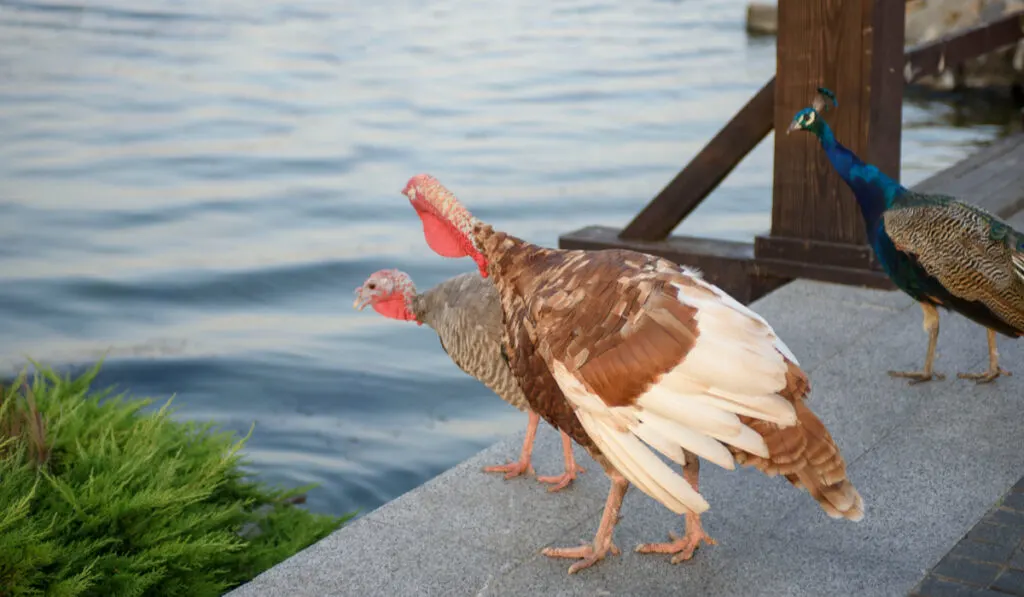
What can go wrong when you raise peacocks and turkeys together? What should you feed your birds? We’ll answer these questions and more in this article.
Table of Contents
Raising Peacocks and Turkeys Together
Feeding Peacocks and Turkeys
When raising animals, you need to first think about what they will eat. For birds such as peacocks and turkeys, they need a lot of proteins to grow feathers, meat, produce eggs, develop their brains, repair and produce cells and tissues, etc.
With the table below, you can analyze the protein needs of peacocks and turkeys:
| Age of Bird | Turkey Crude Protein Requirement | Peacock Crude Protein Requirement |
| 0-3 Weeks | 28% | 30% |
| 3-6 Weeks | 26% | 28% |
| 6-8 Weeks | 26% | 19-20% |
| 8 Weeks > | 22% | 19% |
As you can see from the table above, young peacocks need more proteins than young turkeys. As they grow older, the protein needs of peachicks decline to match that of turkeys until they are around six weeks old.
After six weeks of age, the protein needs of turkeys exceed that of peacocks.
The reason for the difference between the protein needs of peacocks and turkeys is that peachicks (i.e. baby peacocks) need more proteins when they are young to grow their feathers and trains. When they are matured, however, turkeys need more proteins to grow more flesh (meat).
What should peacocks and turkeys eat? You should buy processed turkey or gamebird feed for your turkeys and peacocks.
If local stores around you have a peacock-specific feed, you should feed your peacocks with peacock feed while feeding your turkeys with turkey feed. Gamebird feed is suitable for both birds.
Other food ideas for peacocks and turkeys are:
- Grains
- Mealworms
- Seeds
- Fruits and vegetables.
- Insects, lizards, frogs, etc.
Note that free-range peacocks and turkeys will get sufficient proteins from what they can find, so you should allow your birds to forage.
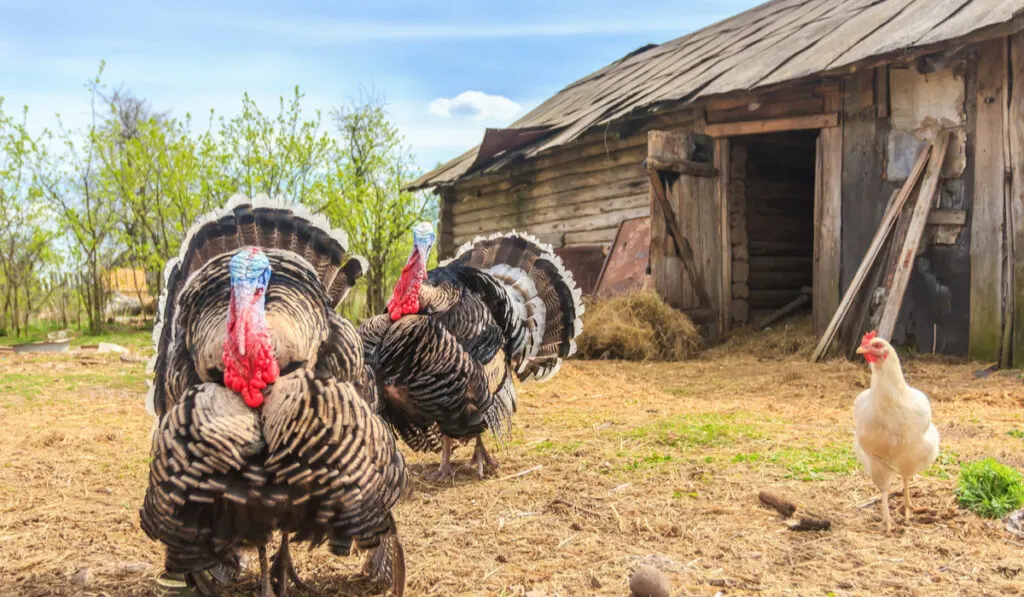
Housing Peacocks and Turkeys
Aside from what your peacocks and turkeys should eat, you need to consider the size of their pen. Unlike chickens that can be kept 1 foot by 1 foot per bird, turkeys need 5 feet by 5 feet per bird. Peacocks, on the other hand, need 10 feet by 10 feet per bird.
Turkeys need space because they can be more aggressive if they do not have much space. Peacocks need space because of their trains.
Make sure that the pen is well-ventilated and insulated.
Prevention of Fighting and Competition between Bird Species
It is not uncommon for turkeys to fight with other birds. Don’t worry, you can prevent your birds from fighting.
Some tips to prevent your birds from fighting are:
- Raise Them as Poults and Peachicks Together: When you raise baby peacocks and turkeys together, they get used to being together at a very young age and will fight less frequently.
- Provide Sufficient Space, Feed, and Water: Birds usually fight for food and space. Providing sufficient resources will reduce how often they fight.
- Raise Fewer Males: The males of many birds usually fight for space and mates. Raising fewer males will prevent your birds from fighting.
As you can see, competition and fighting between turkeys and peacocks can be easy to prevent.
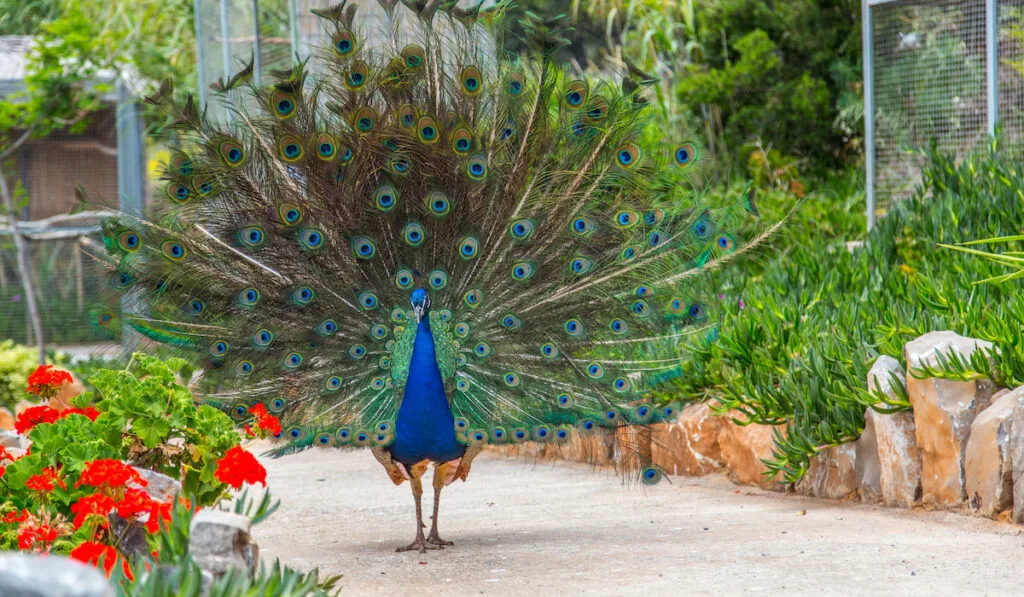
Brooding Peachicks and Poults
Before learning how to brood poults and peachicks, you should know that poults and peachicks grow healthier, stronger, and learn faster when they are raised by their mothers.
You should allow mother peahens and turkeys to raise their young. Only raise your birds in brooder boxes when their mothers are not available.
What You Need to Brood Peachicks and Poults
Here is a list of items that you will need:
1. Brooder Box
A brooder box is an insulated compartment, container, or space in which young birds are raised. Brooder boxes should be big enough to accommodate the number of birds that you want to raise, draft-free, and well-insulated.
2. Bedding
Bedding is important. Bedding helps insulate the brooder box as well as prevent moisture from the poop of your poults and peachicks from building up. Excellent materials for bedding are:
- Wood shavings: Wood shaving is a very popular bedding material because it absorbs moisture quickly and has no harmful effect on your birds. An example of wood shavings you can use is pine shavings. Do not use cedar shavings because they can harm your birds.
- Hay: Hay is a cool bedding material as well. Hay aside from moisture absorption also acts as an insulator to keep the brooder box warm.
- Straw: Just like hay, straw helps to insulate the brooder box.
- Shredded Paper: Paper is not as effective as other bedding materials because it quickly gets soaked. Use paper when other materials are unavailable.
- Dusted Sawdust: Sawdust is a nice bedding material, but you should use sawdust a few weeks after they hatch (i.e. do not use sawdust when your poults or peachicks newly hatch) because your baby birds can sniff some dust from the sawdust which can harm them.
Make sure that 2-5 inches of the brooder floor are covered with bedding.
3. Source of Heat (Heat Lamps)
Young birds need heat to grow and develop. Even though birds are warm-blooded, young birds need an extra source of heat because when they are young, they cannot give themselves as much heat as they need.
The table below shows the heat requirements of baby turkeys (poults) and baby peacocks (peachicks):
| Age of Bird (Weeks) | Best Temperature for Poults | Best Temperature for Peachicks |
| 0-1 | 95 °F | 95 °F |
| 1-2 | 90 °F | 90 °F |
| 2-3 | 85 °F | 85 °F |
| 3-4 | 75 °F | 75 °F |
| 4-5 | Room Temperature | Room Temperature |
| 5 and beyond | Room Temperature | Room Temperature |
(Sources: Poults, Peachicks)
As you can see, turkeys and peacocks need the same temperature in the brooder, so you can brood them together (if you like).
The most common source of heat in brooder boxes is a heat lamp.
4. Other Needs of Poults and Peachicks
Other needs of poults and peachicks include:
- Protein-rich feed
- Clean water
- Love and care
When everything is just right, you will have healthy and strong turkeys and peacocks. Remember that it is best for mother turkeys and peahens to raise their young.
Now you know everything there is to know regarding raising turkeys and peacocks from poults and peachicks, right?
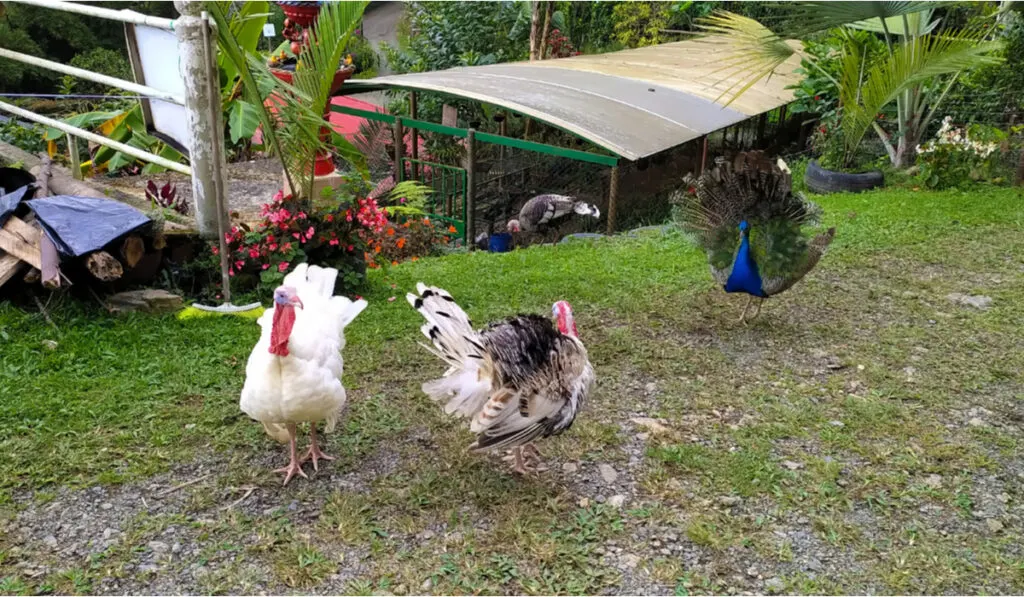
Related Questions and Answers
1. Can Turkeys Kill Peacocks?
If they fight, turkeys might inflict more damage on peacocks because turkeys are stronger than peacocks and do not have a heavy train that can drag them.
Turkeys are aggressive birds that can fight your peacocks when there is competition for food, water, mate, and space. If everything is just right, your turkeys will not fight with your peacocks. It is common to see peacocks tease turkeys though.
2. What Are the Benefits of Raising Turkeys and Peacocks?
Here are cool reasons to raise turkeys and peacocks together:
- Aesthetics: The beauty of peacocks can lighten the mood of you and your visitors. It is a great idea to raise peacocks for their beauty. Turkeys are also beautiful.
- Security: Turkeys can act as an alarm when there are intruders (such as pests, predators, or unknown persons) in your home.
- Pest Control: Both turkeys and peacocks eat animals such as rats, lizards, mice, frogs, snails, etc. Turkeys are very effective in controlling the population of ticks, lice, and mites.
- Meat and Eggs: People raise birds mostly for their meat and egg products. The eggs of turkeys and peacocks are not commonly eaten, but people love good turkey meat.
- As Pets: Wouldn’t you love to raise your favorite birds? Think about it.
3. How Do You Prevent Your Birds from Flying Away?
Peacocks can only fly for a short distance. They prefer walking and only fly when they have to. If they have sufficient feed and everything that they need, they will always return to their pen.
Domestic turkeys, on the other hand, cannot fly and are very territorial. This means that your turkeys actually prefer to stay around instead of going other places.
4. Can You Raise Peacocks and Chickens Together?
It is very possible to raise chickens and peacocks together, but you should not give them the same kind of feed.
Chickens require fewer proteins than peacocks. This means that it will be a waste if your chickens eat your peacock feed and it will not be enough if your peacocks eat your chicken feed.
If you can separate the feed of these birds, you can raise them successfully.
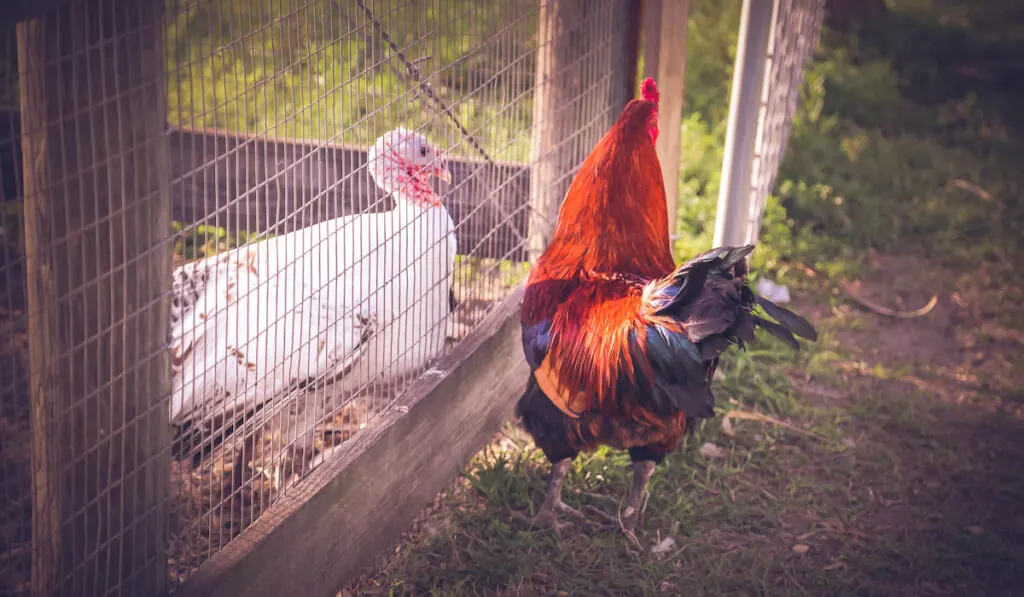
5. Can You Raise Chickens and Turkeys Together?
Turkeys and peacocks are similar when raising them. This means that you can raise chickens and turkeys, but should separate their feeds. Give turkeys feed for turkeys or gamebirds. Give chickens feed for chickens or ducks.
Chickens, turkeys, peacocks, etc. can eat grains, mealworms, and other types of food.
Final Thoughts
Peacocks and turkeys are very compatible and can live together.
They can eat the same types of food and when raised properly, will not fight. Make sure that you provide sufficient food and space to your birds.
Resources
- https://modernfarmer.com/2019/11/are-turkeys-the-new-backyard-chicken
- https://thriftyhomesteader.com/raising-peafowl/
- https://www.backyardchickens.com/threads/anyone-know-how-peacocks-and-turkeys-do-together.177060/
- https://newsfromthecoop.hoovershatchery.com/how-to-keep-multiple-species-of-birds-together/
- https://hellohomestead.com/should-you-add-peacocks-to-your-homestead/
- http://www.grangecoop.com/how-to-raise-baby-turkeys/
